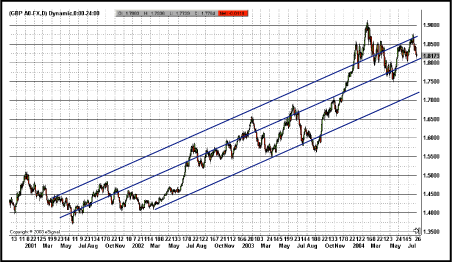Time Frame Within Time Frame
Trading Currencies Using Multiple Time Frames
by Kathy Lien and Patrick Dyess
When trading currencies, it's best to get the big picture first and then use a shorter time frame to select entries and exits.
With $1.5 trillion in daily turnover, the foreign exchange market is the largest market in the world. Previously, access to this market was restricted to hedge funds, large commodity trading advisors (CTAS), and institutional investors due to regulation, capital requirements, and technology. The big players have always wanted access to the market because unlike the equity markets, where liquidity is dispersed across many different stocks, the $1.5 trillion in liquidity is concentrated in four major currency pairs, so they are very liquid. This means that traders can get in and out easily, executing more than $100 million without causing a significant shift in the markets.
TRADING THE TRENDS
Technical analysis is the most common trading strategy used by professional forex traders because currencies rarely spend much time in tight trading ranges and tend to develop strong trends. More than 80% of forex volume is speculative in nature, so as a result, the market frequently overshoots and then corrects itself. A technically trained trader can easily identify new trends and breakouts, providing multiple opportunities to enter and exit positions. In addition, aside from trend trading, certain currencies may undergo extended periods of range trading. Traders can find ample opportunity to play the ends of ranges.
In order to trade successfully on an intraday basis, it is important to be selective. You've heard of the trading cliché “The trend is your friend,” haven't you? Clichés become clichés for good reason -- more often than not, they're true. This one is the tenet for trading, and its importance should not be understated. Trading with the trend while employing trailing stops allows the opportunity to capture big moves in any market.

Figure 1: First step: the daily chart. Since May 2001, the British pound has been in an upward trend, which means that the most effective way to trade this market is to follow the trend.
The goal of multiple time frame analysis is to get traders to think about the big picture first. This can be likened to taking a road trip from Los Angeles to New York. Certainly, there will be left turns and right turns along the way, but it is important to know that overall, you are heading east. In much the same way, in trading, looking for opportunities to buy in an uptrend or sell in a downtrend tends to be much more successful than trying to pick tops and bottoms.
...Continued in the November issue of Technical Analysis of STOCKS & COMMODITIES
Excerpted from an article originally published in the November 2004 issue of Technical Analysis of STOCKS & COMMODITIES magazine. All rights reserved. © Copyright 2004, Technical Analysis, Inc.
Return to November 2004 Contents